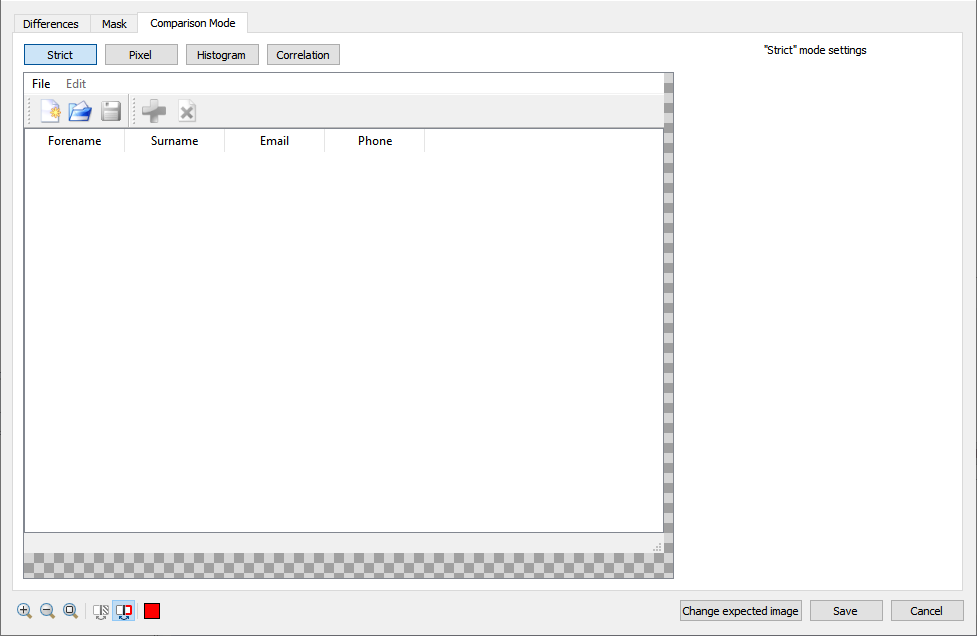Image Comparison Algorithms & Techniques
Learn how image comparison algorithms identify similarities and differences between images for applications like plagiarism detection, medical imaging, and facial recognition.
Learn how image comparison algorithms identify similarities and differences between images for applications like plagiarism detection, medical imaging, and facial recognition.
Determining if two images are identical or similar plays a crucial role in various applications, from object recognition to image retrieval. This article explores different image comparison techniques, each offering a unique approach to quantifying image similarity. We'll delve into code examples using Python libraries like PIL, skimage, imagehash, and OpenCV to illustrate these methods.
from PIL import Image
import numpy as np
img1 = Image.open("image1.jpg")
img2 = Image.open("image2.jpg")
# Calculate the difference between each pixel
diff = np.array(img1) - np.array(img2)
# Calculate the Mean Squared Error (MSE)
mse = np.sum(np.square(diff)) / (img1.width * img1.height)from skimage.metrics import structural_similarity as ssim
# Calculate SSIM
ssim_index = ssim(img1, img2, multichannel=True)import imagehash
hash1 = imagehash.average_hash(Image.open('image1.jpg'))
hash2 = imagehash.average_hash(Image.open('image2.jpg'))
# Calculate the Hamming distance between the hashes
hamming_distance = hash1 - hash2import cv2
# Initiate SIFT detector
sift = cv2.SIFT_create()
# Find the keypoints and descriptors with SIFT
kp1, des1 = sift.detectAndCompute(img1, None)
kp2, des2 = sift.detectAndCompute(img2, None)
# BFMatcher with default params
bf = cv2.BFMatcher()
matches = bf.knnMatch(des1, des2, k=2)# Calculate histograms
hist1 = cv2.calcHist([img1], [0], None, [256], [0, 256])
hist2 = cv2.calcHist([img2], [0], None, [256], [0, 256])
# Compare histograms using correlation
correlation = cv2.compareHist(hist1, hist2, cv2.HISTCMP_CORREL)These are just a few examples, and the best algorithm will depend on the specific application and the types of images being compared.
This Python code compares two images ("image1.jpg" and "image2.jpg") using five different methods: pixel-by-pixel comparison (Mean Squared Error), structural similarity (SSIM), image hashing (Average Hash and Hamming Distance), feature detection and matching (SIFT), and histogram comparison (correlation). It outputs the results for each comparison method, providing insights into the level of similarity between the two images.
# Import necessary libraries
from PIL import Image
import numpy as np
from skimage.metrics import structural_similarity as ssim
import imagehash
import cv2
# Load images
img1 = Image.open("image1.jpg").convert('RGB') # Ensure images are in RGB format
img2 = Image.open("image2.jpg").convert('RGB')
# 1. Pixel-by-Pixel Comparison (Mean Squared Error)
diff = np.array(img1) - np.array(img2)
mse = np.sum(np.square(diff)) / (img1.width * img1.height)
print(f"Mean Squared Error (MSE): {mse}")
# 2. Structural Similarity Index (SSIM)
ssim_index, _ = ssim(np.array(img1), np.array(img2), multichannel=True, full=True)
print(f"Structural Similarity Index (SSIM): {ssim_index}")
# 3. Hashing (Average Hash and Hamming Distance)
hash1 = imagehash.average_hash(img1)
hash2 = imagehash.average_hash(img2)
hamming_distance = hash1 - hash2
print(f"Hamming Distance: {hamming_distance}")
# 4. Feature Detection and Matching (SIFT)
# Convert PIL images to OpenCV format
img1_cv = cv2.cvtColor(np.array(img1), cv2.COLOR_RGB2BGR)
img2_cv = cv2.cvtColor(np.array(img2), cv2.COLOR_RGB2BGR)
# Initiate SIFT detector
sift = cv2.SIFT_create()
# Find the keypoints and descriptors with SIFT
kp1, des1 = sift.detectAndCompute(img1_cv, None)
kp2, des2 = sift.detectAndCompute(img2_cv, None)
# BFMatcher with default params
bf = cv2.BFMatcher()
matches = bf.knnMatch(des1, des2, k=2)
# Apply ratio test to filter good matches
good_matches = []
for m, n in matches:
if m.distance < 0.75 * n.distance:
good_matches.append([m])
print(f"Number of Good Matches (SIFT): {len(good_matches)}")
# 5. Histogram Comparison (Correlation)
hist1 = cv2.calcHist([img1_cv], [0, 1, 2], None, [8, 8, 8], [0, 256, 0, 256, 0, 256])
hist2 = cv2.calcHist([img2_cv], [0, 1, 2], None, [8, 8, 8], [0, 256, 0, 256, 0, 256])
correlation = cv2.compareHist(hist1, hist2, cv2.HISTCMP_CORREL)
print(f"Histogram Correlation: {correlation}")Explanation:
Pixel-by-Pixel Comparison (MSE):
Structural Similarity Index (SSIM):
Hashing (Average Hash and Hamming Distance):
Feature Detection and Matching (SIFT):
Histogram Comparison (Correlation):
Remember:
General Considerations:
Specific Notes:
Additional Techniques:
Choosing the Right Method:
The best image comparison method depends on your specific application requirements. Consider the following factors:
This document summarizes various techniques for comparing the similarity between two images:
| Technique | Description | Python Example | Strengths | Weaknesses |
|---|---|---|---|---|
| Pixel-by-Pixel Comparison | Directly compares corresponding pixel values. | np.sum(np.square(np.array(img1) - np.array(img2))) / (img1.width * img1.height) |
Simple to implement. | Highly sensitive to noise, shifts, and scaling. |
| Structural Similarity Index (SSIM) | Measures similarity based on perceived structural information. | ssim(img1, img2, multichannel=True) |
More robust to minor image distortions than pixel comparison. | Computationally more expensive than pixel comparison. |
| Hashing | Generates a compact hash value representing image content. Similar images have similar hashes. | hamming_distance = imagehash.average_hash(img1) - imagehash.average_hash(img2) |
Fast and efficient for large-scale comparisons. | Less accurate for subtle differences. |
| Feature Detection and Matching | Identifies and compares key features (keypoints and descriptors) between images. | matches = cv2.BFMatcher().knnMatch(des1, des2, k=2) |
Robust to changes in viewpoint, illumination, and scale. | Computationally intensive. May struggle with images lacking distinct features. |
| Histogram Comparison | Compares the color distributions of two images. | cv2.compareHist(hist1, hist2, cv2.HISTCMP_CORREL) |
Relatively simple and fast. Invariant to image translations and rotations. | Ignores spatial information, making it sensitive to changes in object arrangement. |
Note: The best algorithm for image similarity comparison depends on the specific application and the types of images being compared.
In conclusion, the optimal approach for image comparison hinges significantly on the specific application and the nature of the images being analyzed. Whether prioritizing the simplicity of pixel-by-pixel comparison, the perceptual relevance of SSIM, the efficiency of hashing, the robustness of feature matching, or the color distribution focus of histogram comparison, each technique presents its own strengths and limitations. Selecting the most appropriate method, or even combining multiple techniques, requires careful consideration of factors such as accuracy requirements, image characteristics, computational constraints, and the types of similarities being sought. As the field continues to advance, exploring and understanding these image comparison techniques remains crucial for developers and researchers across various domains.
 Algorithms for Image Comparison - GeeksforGeeks | A Computer Science portal for geeks. It contains well written, well thought and well explained computer science and programming articles, quizzes and practice/competitive programming/company interview Questions.
Algorithms for Image Comparison - GeeksforGeeks | A Computer Science portal for geeks. It contains well written, well thought and well explained computer science and programming articles, quizzes and practice/competitive programming/company interview Questions. Understanding Different Image Comparison Algorithms | Understanding Different Image Comparison Algorithms
Understanding Different Image Comparison Algorithms | Understanding Different Image Comparison Algorithms Algorithms for Image Comparison | Baeldung on Computer Science | Explore three algorithms for image comparison
Algorithms for Image Comparison | Baeldung on Computer Science | Explore three algorithms for image comparison Pro and cons with deconvolution algorithm (comparison) - Image ... | Dear all, I need your help for a comparison of deconvolution algorithm to understand better how to use correctly deconvolution. Weiner filter Ridcharson lucy Adaptative algorithm etc… Thank you very much
Pro and cons with deconvolution algorithm (comparison) - Image ... | Dear all, I need your help for a comparison of deconvolution algorithm to understand better how to use correctly deconvolution. Weiner filter Ridcharson lucy Adaptative algorithm etc… Thank you very much Deconvolution algorithm 'State of the Art' (SOTA) - Image Analysis ... | What does it mean? I have been trying to publish a new algorithm for image deconvolution but several reviewers have come back criticising that my method has not been compared to the ‘State of the Art’ (as if that’s a bad thing). I find this hard to understand. Surely you compare your scientific method to something similar to it - as a scientist I mean. That is what I do in my paper (I compare my method to maximum entropy because they have certain similarities to each other). If I were a commer...
Deconvolution algorithm 'State of the Art' (SOTA) - Image Analysis ... | What does it mean? I have been trying to publish a new algorithm for image deconvolution but several reviewers have come back criticising that my method has not been compared to the ‘State of the Art’ (as if that’s a bad thing). I find this hard to understand. Surely you compare your scientific method to something similar to it - as a scientist I mean. That is what I do in my paper (I compare my method to maximum entropy because they have certain similarities to each other). If I were a commer...